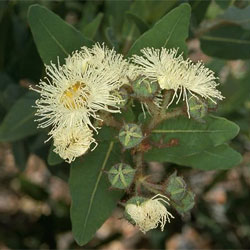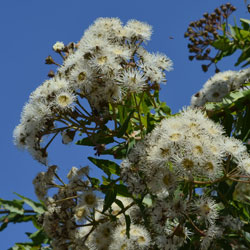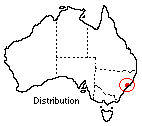Angophora hispida
 |
 |
Dwarf Apple, Scrub Apple
Angophora hispida (Sm.) Blaxell
Angophora hispida, the Dwarf Apple or Scrub Apple, with its twisted growth habit, gnarled branches and rough loose bark would make an interesting addition to a garden of Australian character. Its young branches and inflorescences covered with reddish hairs throughout the year heighten its appeal.
It occurs naturally on scrubby ridges in parts of the Hawkesbury sandstone area between the Royal National Park and Gosford, New South Wales as a shrub or small twisted tree up to 6 m in height.
 Confined
to Australia, there are thirteen species of evergreen trees and shrubs within
this genus which belongs to the family Myrtaceae and the closely related genera Corymbia and Eucalyptus. Their
botanical characteristics differ in that Angophora has opposite leaves
whereas in Corymbia and Eucalyptus they are mostly alternate,
except for juvenile leaves and several species that retain this type of foliage
throughout their life.
Confined
to Australia, there are thirteen species of evergreen trees and shrubs within
this genus which belongs to the family Myrtaceae and the closely related genera Corymbia and Eucalyptus. Their
botanical characteristics differ in that Angophora has opposite leaves
whereas in Corymbia and Eucalyptus they are mostly alternate,
except for juvenile leaves and several species that retain this type of foliage
throughout their life.
The leaves do not have the oily smell of most eucalypts and there is no operculum or cap covering the undeveloped flowers as there is in the other two genera.
The flowers of Angophora hispida are rather large with 4-6 in each cyme (the inflorescence) forming a fairly dense terminal cluster. They are typical of so many Myrtaceae genera in that their chief attractive feature is the numerous stamens which form a circular spreading mass. The filaments are white and the anthers yellow.
The flowering period is in January when clusters of creamy white flowers provide a striking contrast against a background of olive-green leaves.
The leaves are leathery, heart-shaped and without a stalk while the fruit is a capsule which is distinctly ribbed with five triangular-shaped 'calyx teeth' adhering to their rims. When ripe the capsule opens suddenly to release three flat seeds, so the tree must be kept under observation if its seed is to be collected.
Although this species is not commonly grown in Canberra it is worthy of cultivation, particularly as a feature specimen in a corner of the garden which is not too exposed. There are two fully grown specimens of A. hispida in the Australian National Botanic Gardens and no pests or diseases have been apparent. During the flowering season, colourful beetles are attracted to the nectar-laden blossoms as are numerous birds.
Propagation is from seed which may be germinated in a mixture of coarse washed river sand and perlite. On planting out, some protection from frost may be necessary until the plant becomes established. The plants will benefit from the application of a complete fertilizer in spring. If preferred Dwarf Apple can be kept as a shrub for a number of years by periodic pruning.
Text by ANBG staff (1976) with minor revision in 2002.
Name meaning: Angophora hispidaAngophora - derived from Greek words, aggos, a vessel,and phero, to bear, an allusion to the shape of the fruit; hispida - covered with coarse erect hairs |
![An Australian Government Initiative [logo]](/images/austgovt_brown_90px.gif)

